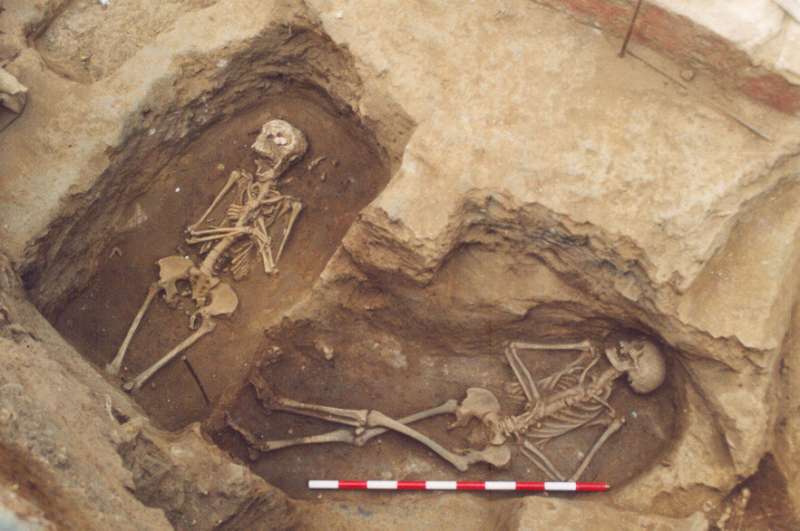Two adult burials from Vila de Madrid necropolis. Credit: MHCB, CC-BY 4.0 (creativecommons.org/licenses/by/4.0/)
A team of researchers affiliated with several institutions in Spain, working with a colleague from South Africa, has found that for some people living in the Roman Empire, funerary meals were much like everyday meals. In their paper published on the open-access site PLOS ONE, the group describes their study of human and animal remains found in ancient graves at Vila de Madrid, a necropolis that was located outside of the ancient Roman city of Barcino (modern Barcelona).
During the time of the Roman Empire, rules were made for conquered lands that tended to coincide with rules that the Romans themselves followed. One set of rules governed funeral arrangements. And one of those rules mandated that an animal (or part of one) must be sacrificed and placed into the grave with the person who had died—regardless of age, gender or social status. In this new effort, the researchers looked into how that mandate was carried out by people living in one part of Spain.
In their work, the researchers looked at the remains of 41 people who had been found in the ancient necropolis along with the remains of 50 animals that had also been found in the graves. They note that they expected to find that the animal sacrifices would be of a special kind—after all, it was meant to be consumed by the dead person as they made their way from an earthly realm to whatever the afterlife held in store. But that was not what they found. Instead, they found that meat placed in a grave was pretty much the same type and quality as the meat the person would have been eating before they died.
The researchers came to this conclusion by carefully studying the bones and teeth of the deceased people to learn more about what they had been eating in the years leading up to their death. They then compared what they found to the food found in the grave with the deceased person. They did find that rich people tended to eat better than poor and therefore had more expensive types of meat in their graves. But in general, the deceased person's diet did not change much as they made their way to their afterlife.
The researchers also found a few exceptions, such as graves with no animal bones and a couple of individuals who appeared to have had radically different diets than everybody else. They plan to continue their work to learn more about how burials were conducted for those interred at Vila de Madrid.
More information: Domingo C. Salazar-García et al, Food for the soul and food for the body. Studying dietary patterns and funerary meals in the Western Roman Empire: An anthropological and archaeozoological approach, PLOS ONE (2022). DOI: 10.1371/journal.pone.0271296
Journal information: PLoS ONE
© 2022 Science X Network
























